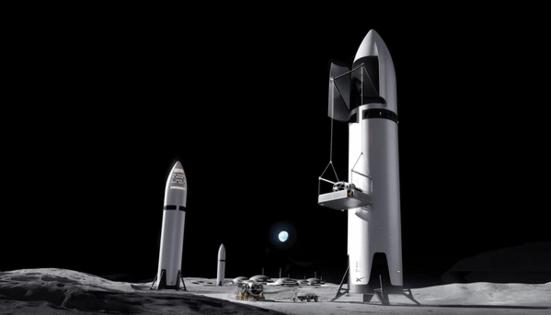After NASA pressure, SpaceX promises speedier timeline for Starship moon lander
Published in Science & Technology News
ORLANDO, Fla. — After acting NASA Administrator Sean Duffy this month called out SpaceX for Starship delays, Elon Musk’s company has come back with an update defending its progress and offering a speedier plan to get astronauts back on the moon as part of the Artemis program.
“Starship continues to simultaneously be the fastest path to returning humans to the surface of the moon and a core enabler of the Artemis program’s goal to establish a permanent, sustainable presence on the lunar surface,” reads a statement published to SpaceX’s website on Thursday.
Duffy said he would open back up a contract that SpaceX had won in 2021 to be the human landing system for the Artemis III mission that looks to return humans to the surface of the moon for the first time since the end of the Apollo program in 1972.
“I love SpaceX. It’s an amazing company,” Duffy said. “The problem is they’re behind. They push their timelines out, and we’re in a race against China.”
That mission is the follow-on to Artemis II, which is slated to fly around, but not land on, the moon as early as February next year. Artemis III was on NASA’s roadmap to launch by summer 2027, but Duffy said that timeline has been threated, and he was reopening the contract that could bring in Jeff Bezos’ Blue Origin potentially to service that mission instead.
Duffy said he wanted to ensure that moon landing, which is headed to the lunar south pole, would come before the end of Trump’s term in office, as well as win what’s being called the second space race with the Chinese, who just this Thursday said they expect to land by 2030.
Duffy’s comments prompted criticism from Musk who called him “Sean Dummy” and that he had a “2 digit IQ.”
But SpaceX’s update crafted a defense of the Starship program with a little more aplomb, praising NASA’s Artemis program goals, and promoting its renewed efforts.
“Since the contract was awarded, we have been consistently responsive to NASA as requirements for Artemis III have changed and have shared ideas on how to simplify the mission to align with national priorities,” the post reads. “In response to the latest calls, we’ve shared and are formally assessing a simplified mission architecture and concept of operations that we believe will result in a faster return to the moon while simultaneously improving crew safety.”
The path forward is to continue building out infrastructure at Kennedy Space Center’s Launch Pad 39-A and Cape Canaveral Space Force Station’s Space Launch Complex 37, which SpaceX wants to use as its two main operational pads for when Starship is out of testing phase. Both sites, though, need launch licenses from the Federal Aviation Administration, and are both still amidst ongoing Environmental Impact Statements.
Meanwhile, suborbital test launches of Starship will continue from SpaceX’s Texas launch site Starbase.
The company’s statement says it has been pursuing Starship development on two paths, one that looks to get the core rocket launch and landing system working, and a second that will satisfy NASA’s human-rated landing needs on the moon.
The 11 suborbital test launches SpaceX has performed since April 2023 have knocked out many of the company’s goals, but it has yet to complete a safe landing of the upper stage back at the launch site.
SpaceX has manufactured more than three dozen Starships and 600 Raptor engines, and more will be coming as it completes new facilities in Florida, Texas and California. That includes a Starship manufacturing site under construction at Kennedy Space Center that is part of a $1.8 billion infrastructure project.
The next steps look to hit milestones in 2026 that will open up the eventual Starship launch to the moon. That includes a ship-to-ship propellant transfer demonstration, because the moon lander will need to refuel several times using depots parked in the more than 220,000 miles of cislunar space between Earth and the moon.
That test as well as a long-duration flight test are both on track to fly next year, SpaceX stated.
“It will start with a Starship launched from Starbase to spend an extended time on orbit, gathering data on vehicle propulsion and thermal behavior on an extended duration mission, including long-duration propellant storage and boil-off characterization,” the post stated. “A second Starship will then launch to rendezvous with the first to demonstrate ship-to-ship propellant transfer in Earth orbit.”
Meanwhile SpaceX has begun to fabricate a test version of that moon lander Starship cabin “that will include functional avionics and power systems, crew systems and mechanisms, environmental control and life support systems, cabin and crew communications systems, and a cabin thermal control system.”
“This flight-capable cabin will enable engineers to demonstrate high design maturity of the various systems required to support a human landing on the moon, enable integrated system-level hardware testing, and provide a highly realistic training experience for future lunar explorers,” the post reads.
SpaceX touts that its NASA deals are fixed-price contracts, and the company has self-funded 90% of Starship development to date.
“The company is only paid after the successful completion of progress milestones,” the post stated. “American taxpayers are not on the hook for increased SpaceX costs.”
-----------
©2025 Orlando Sentinel. Visit at orlandosentinel.com. Distributed by Tribune Content Agency, LLC.







Comments